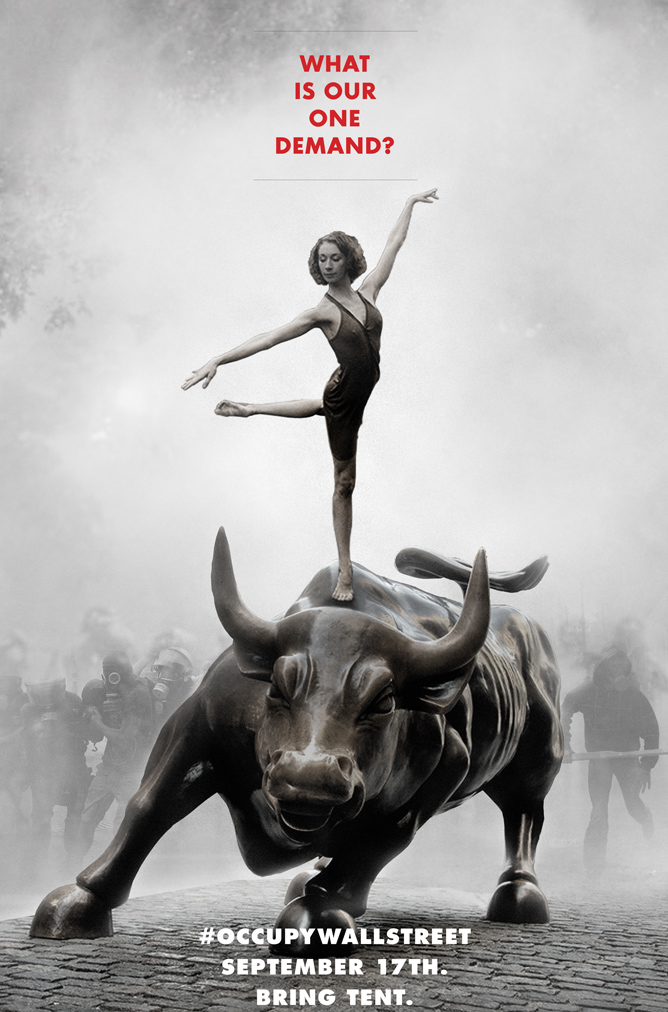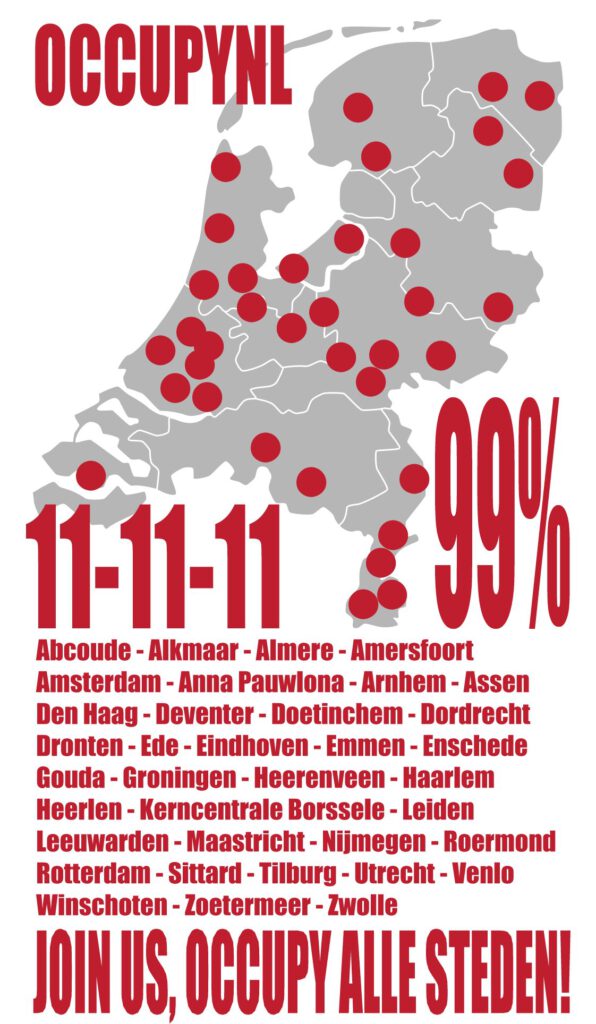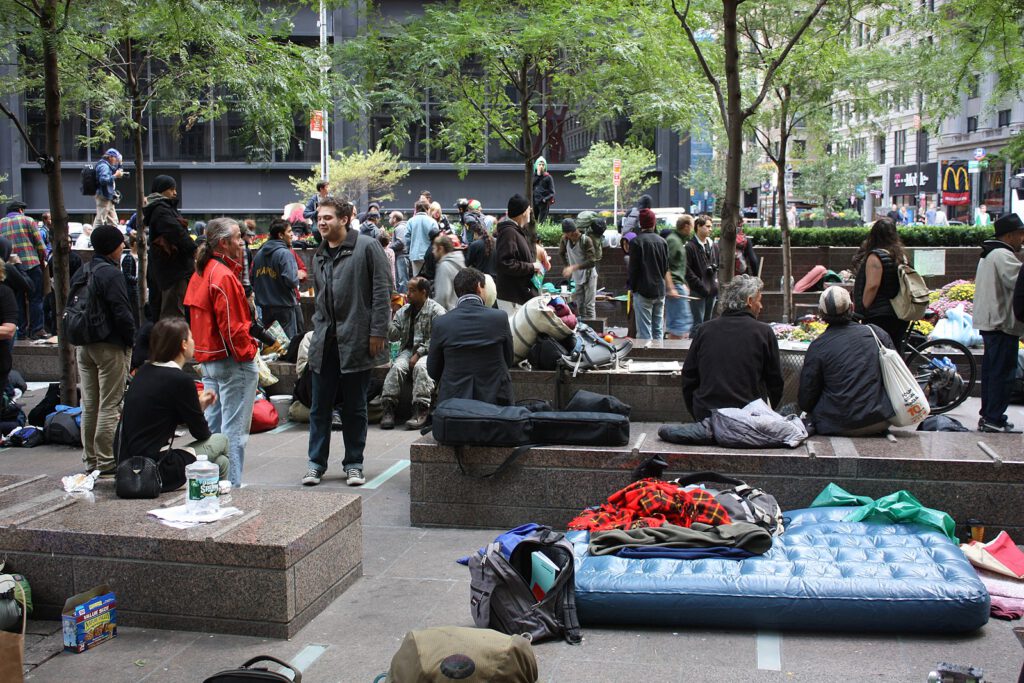GRassroots Movements
"We Are the 99%"
Occupy in the netherlands and on wall street
In July 2011, an Adbusters blogpost called on readers to stand up against the influence of corporations in American politics and physically flood onto Wall Street in September: “On September 17, we want to see 20,000 people flood into lower Manhattan, set up tents, kitchens, peaceful barricades and occupy Wall Street for a few months. Once there, we shall incessantly repeat one simple demand in a plurality of voices.”[1] Inspired by different anti-globalization movements occurring worldwide as a consequence of the Great Recession, this post urged readers to see what was wrong in American leadership. The accompanying poster of the Wall Street Bull indicates the slogan “What is our one demand?” while showing a symbol of Wall Street and Bowling Green surrounded by people in gasmasks.
our one Demand

The slogan “We are the 99%” became the rallying call to participants of the Occupy Wall Street Movement, referring to how the economic top 1% of the country ruled over the middle-, lower and poor socio-economic classes. The Movement was a reaction to both American and European politicians deciding to bail out large private banks, forcing taxpayers to pay for the mistakes made by bankers, without gaining control of those banks or passing legislation to prevent a similar crash from taking place again.[1] While the initial protest on September 17, 2011, was not as large as organizers had hoped, participants did persist and ended up camping in Zuccotti Parc in lower Manhattan, close to Wall Street. The movement grew more and more, and gained international media attention when the New York Police Department tried to disband the camp. This in turn led to the creation of different Occupy movements all over the world, including across the Atlantic Ocean.
Image
© Adbusters, “#OCCUPYWALLSTREET,” Internet Archive: Wayback Machine, archived from the original on July 13, 2011, https://web.archive.org/web/20110717094726/http://www.adbusters.org/blogs/adbusters-blog/occupywallstreet.html.
Sources
Hans-Werner Sinn, “Socialising Bank Debt Will Plunge Europe into a Deeper Crisis,” The Guardian, June 13, 2012, www.theguardian.com/business/2012/jun/13/socialising-bank-debt-europe-deeper-crisis.
From global to local
Protests took up in the Netherlands in November 2011 after the Wall Street movement grew into a global one. European banks and, by extension, Dutch banks, had been hit by the financial crisis that began in the US in 2008, and the Great Recession had caught up to Dutch citizens as well. With similar motivations and protest tactics to the Wall Street movement, the Dutch made their discontent with their politicians clear. Occupy movements started locally and were organized in individual cities instead of in a central manner. Participant in different cities sometimes used various methods to protest, but all were welcome to participate. The issues protested by Dutch Occupiers were similar to the Americans, namely corporate influence on democratic political institutions.
Both the American and the Dutch Occupy Movements were “horizontal” movements, meaning that there would be a democratic organization without people at the top making decisions for the entirety of the movement. Therefore, everyone with a cause was welcome to join the movement and make their point through either marching with the movement or occupying parks and/or streets. The occupation of parcs was often referred to as “reclaiming” public spaces taken over by private corporate banks or enterprises.
Image
© Join Us, Occupy Alle Steden! image, Globalinfo, published on November 11, 2011, https://www.globalinfo.nl/Nieuws/update-occupy-verder.
Sources
“Occupy ook in Nederland,” NOS, 15 Oct. 2011, nos.nl/video/304070-occupy-ook-in-nederland.html.
“Learn about #Occupy,” Occupy Together, Internet Archive: Wayback Machine, archived from the original on July 1, 2014, https://web.archive.org/web/20130622015157/http://www.occupytogether.org:80/aboutoccupy.

Normal People
While the movement had spread internationally, this did not mean that the issues participants protested were the same everywhere. In the Netherlands specifically, the financial crisis had not hit politics as harshly as, for example, Southern European countries, and austerity measures were less strict for the Dutch population. Dutch occupiers were more concerned with the unchecked influence of banks on their government than their government itself. They were also less concerned with welfare policies and protections for lower socio-economic classes, as those are more embedded into Dutch society than they are in the US. Access to healthcare insurance, lower unemployment and higher minimum wages are examples of policies the American Occupy Movement was fighting for, when those kinds of guarantees were already present for Dutch citizens. Instead, the Dutch were more focused on advocating against multinational corporations and favored smaller local businesses or cooperative companies to be created by “normal people.”

Occupy participants in Zuccotti parc in New York City on 18 September 2011. Image © Bruno Sanchez-Andrade Nuño, Occupy Wall Street, image, https://commons.wikimedia.org/wiki/File:Occupy_Wall_Street_(6173546071).jpg. Creative Commons License (CC-by-2.0), https://creativecommons.org/licenses/by/2.0/deed.en.